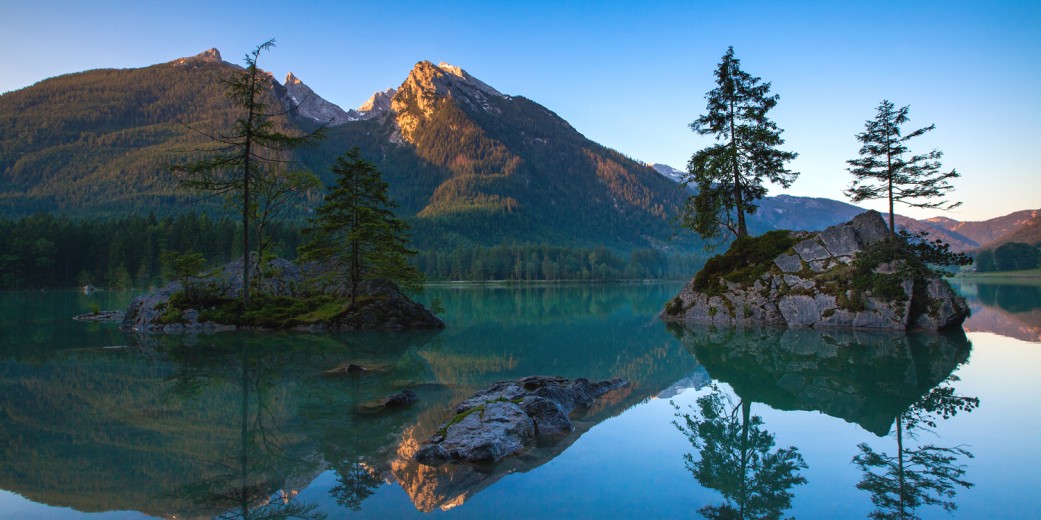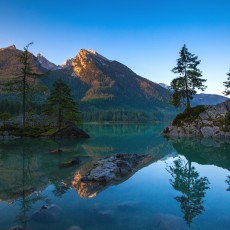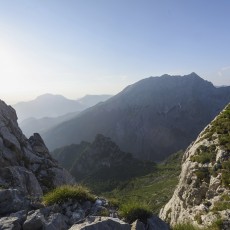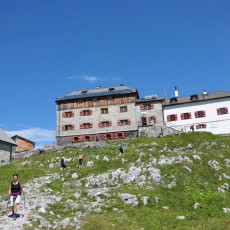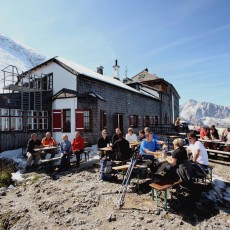The legendary "Watzmann"
Not only is the Watzmann the highest peak of the administrative district and one of the highest of Germany. In addition, it is actually the highest peak which is located entirely on German territory. In comparison the Zugspitze (which is actually the highest peak of Germany) is located exactly on the boarder between Germany and Austria.
The Watzmann mountain range actually consists of severeal independent peaks and sub-peaks. The highest, the so called “Middle-Peak” of the Watzmann, with its 2.713 m above sea level is followed by the “Southern Peak” (2712 m) and the “Hocheck” (2651 m).
Fairly famous peaks lie in the east of the main ridge divide: the so called “Wife of the Watzmann” and its “Seven Kids”.
Looking at the Watzmann from Berchtesgaden the shape of the mountain range can be interpreted as the wife to the left, followed by 7 subpeaks (“the kids”) and the main Watzmann massive (“the King”).
However, a much more interesting explanation of this characteristic rock formations is given by a famous legend. Once apon a time a king – or shall we rather say a ruler – has reigned the region in a very cruel way, always longing for more power. As a punishement for his cruelties the king was turned into stone alongside his wife and the seven kids.
Valentin Stanic, a theologian from Slovenia, was the first man to climb the Watzmann in 1800 along the easiest approach from the south.
Much more challenging, however, is the climb through the enormous east face of the Watzmann. Actually, with an elevation difference of 1.800 m from buttom to top, this rock face is the highest of the Eastern Alps. It was not before 1881 that the first ascent of the face was accomplished by Johann Grill (rather known as “Kederbacher”), a mountainguide from Ramsau, in company with Wiener Otto Schück. Another milestone of alpinistic history was set by none other than the famous mountaineer Herman Buhl himself. He managed the first winter ascent of the same rock face in 1953. For him, however, this heroic achievement was just part of his training and preparation for the first ascent of the 8.125 m high Nanga Parbat in the Himalayas.
And today the Watzmann is a little gem of mountain range with a lot to offer: an easy stroll in the Wimbach valley, a family hike to the Watzmannhaus or scrambles, alpine ridge traverses and rock climbing routes.
The most popular “base camp” for trips on the Watzmann is the alpine hut “Watzmannhaus”. Built in 1888 at 1.928 m elevation, this hut has ever been managed by the German Alpine Club and offers food, drinks and quite luxurious accomodation to everyone.
The Watzmannhaus is the ideal starting point for the long and challenging traverse of the entire Watzmann – Ridge, including the long and tiring descent into the Wimbach valley. This itinerary is therefore only recommended for mountaineers with a solid endurance and a good experience in exposed alpine terrain.
During the last century several efforts have been undertaken to establish a cable car to the summit of the Watzmann. Thanks to the enduring resistance of environmental NGO’s these plans never became reality. As soon as the National Parc Berchtesgadener Alpen was established these plans were definately forgotten.





